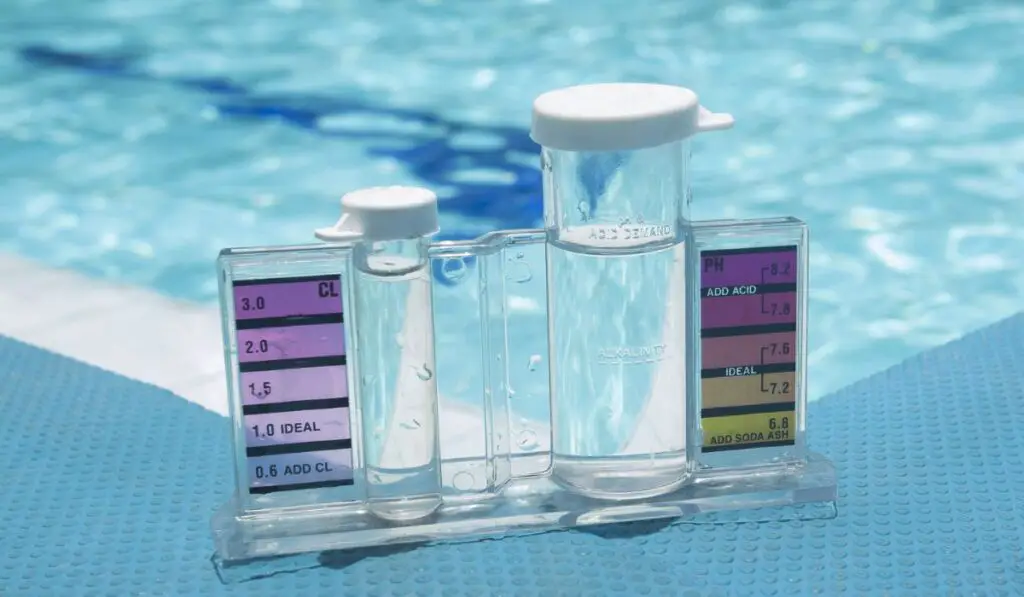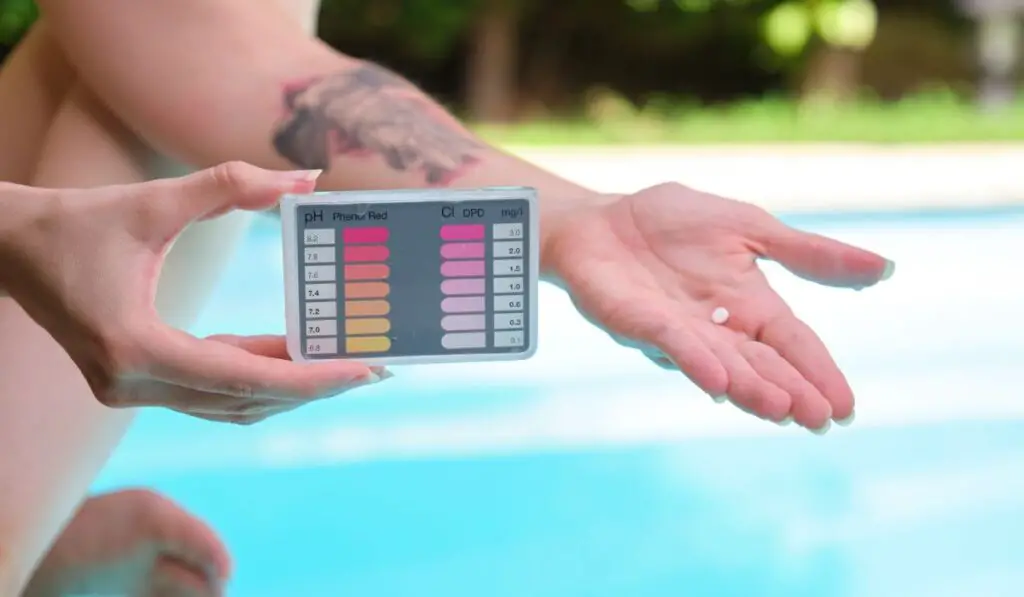A high pH level in your pool is never good news. Not only can it harm your health, but it can also damage your pool. So, what causes pH levels to go up, and how can you balance them out?
A pool’s pH level reflects how acidic or basic (alkaline) the water is. The pH level may be too high due to pool shock, pH increasers, algae, hard water, or the use of certain pool features, among other causes. To lower the pH, use muriatic acid or sodium bisulfate, also known as “dry acid.”
Let’s take a closer look at what pH levels indicate, the ideal pH level for a pool, and what to do if the pH level in your pool is too high.
What Is pH?

Your pool’s pH level is a reflection of how acidic or basic (alkaline) your pool water is. The pH level can range from 0 to 14. A level of 7 is considered neutral and balanced.
A pH of 7 or below indicates the pool water is too acidic. On the other hand, a pH of over 7.6 means it has high alkalinity.
Ensuring your pH level remains neutral will help you avoid water irregularities. A low pH level means your water can easily become bacteria ridden, while a high pH level indicates that you could risk damaging your health and the condition of your pool.
How Often Should You Test Your Pools pH Levels?
Your pool’s pH level should be tested three or four times weekly to guarantee it’s safe and clean.
Luckily, it’s easy to test your pool with an affordable pH test kit, like this one (on Amazon). Test strips, which can be dipped directly into the pool water, are a practical and convenient option for testing.
The strip will show you the pH level and help you understand whether you need to do anything to lower or increase the level.
pH vs. Alkalinity: What’s the Difference?
The pH of water relates to the acidity of your water. pH determines the concentration of acid protons.
Alkalinity refers to how well a solution can neutralize acids. It’s best to test alkalinity before pH because an alkalinity imbalance will quickly hinder a pool’s pH level. When a pool’s alkalinity is balanced, it will be easier to balance the pH.
What Causes a Pool to Have a High pH Level?
The pH levels in your pool can quickly rise and fall. Several factors can cause your pool’s pH level to get too high, including the following:
Pool Shock
Shocking your pool is required to help remove contaminants that hinder the cleanliness and hygiene of your pool water.
However, pool shock could also be the reason why your pH is too high. Shock chemicals will raise the hardness of your water and its alkalinity. Hence, it will certainly increase your pool’s pH level.
pH Increasers
Likewise, pH increasers will increase your pH levels. You might unknowingly use them while using another pool product that contains baking soda or borax. Therefore, be sure to check the ingredients in your pool products to avoid using chemicals that will work to raise the pH level.
High pH Water
Using hard water in your pool will slowly increase the pH level. Using low-alkalinity water will help you stabilize your pH level.
Algae in the Pool
Any algae in the pool will affect the pH level. Algae feed on carbon dioxide, which will impact the pH level in your pool.
If you leave algae untreated, you risk a dangerous pH level. Therefore, treat algae as soon as you notice it to reduce the risk of a pH imbalance. To treat algae in the pool, you can use an algaecide like this one (on Amazon).
Salt Water
Naturally, saltwater pools have higher pH levels than regular pools. Saltwater pools don’t use chlorine tablets, and this can cause an imbalance in the water.
Plus, when saltwater generators work, they create small bubbles filled with carbon dioxide, which can cause water pH levels to rise.
Water Features
Certain pool water features could be the reason your pool’s pH level has risen. They cause more movement in the pool, which has a similar effect to a saltwater generator.
These features can cause carbon dioxide to release from your water, slowly increasing the pH level.
Pool Plastering
Pool plastering is used during pool resurfacing. Plaster contains calcium hydroxide, which has a natural pH level of 12.
New plaster guarantees an increase in pH levels, so be cautious when cleaning your pool after installing new plaster. A thorough cleaning can help you avoid high pH levels when adding new water.
High Total Alkalinity
When water’s alkalinity is high, it will speed up the release of carbon dioxide. This will cause your pH level to rise. The rise can be prevented using diluted water.
What Causes a Low pH?
Now that you know causes high pH levels, let’s take a look at the opposite issue. There are several factors can cause a dip in a pool’s pH level, including the following:
Swimmers
When people use a pool, they can release sweat and saliva, which are acidic. When water becomes acidic, the pH level will go down.
Pool Water Issues
Your local water supply might have a low pH level, which will lower the pH level of your pool. Using your own water with a balanced pH level will help balance your pool’s pH.
Rainwater
Rainwater is naturally acidic, so it will naturally lower your pool’s pH level. Groundwater can have a similar effect.
Chemicals
If you have added too many chemicals to lower a high pH level, it could make the level too low instead of balanced. Add chemicals slowly and retest as you go instead of adding too much at once.
How Do You Lower a Pool’s pH Levels?

Lowering your pool’s pH levels isn’t too challenging. Be patient as you proceed so that you don’t have to repeat the steps.
In order to lower your pH levels, you can use a chemical called muriatic acid (which you can find on Amazon) or sodium bisulfate (also on Amazon), which is also known as “dry acid.”
Here’s how to lower a pool’s pH levels:
- Test the water. The first thing you will need to do before messing with your pool’s pH level is to test the water with a kit. This will help you determine the water’s current pH level so that you can adjust it accordingly. Anywhere between 7.2 and 7.8 is ideal. If the test results in a higher pH level, follow the next steps.
- Measure your pool volume and chemicals. Next, you’ll need to understand how much water is in your pool. If you know this, you can go ahead and measure.
To measure your pool volume, measure the size (length, width, and depth), multiply these numbers, and then multiply the total by 7.5.
Next, you’ll need to measure your chemicals to add the correct amount (or as close to correct as possible) to achieve a balanced pH level. You can do this by using an online calculator and following these steps:
- Enter the size of your pool and current pH level.
- Set your pH level to 7.2 and 7.8, and enter your total alkalinity.
- Set the target level to 80 and 120 ppm.
- Enter the size of your pool and current pH level.
- Add the chemicals and retest the water. Now, it’s time to add the chemicals. Add 75% of the acid at first to avoid adding too much. If you use muriatic acid, pour this into the deepest area. If you use dry acid, dissolve the granules before pouring the mixture in. Then, retest the water and ensure the pH is between 7.2 and 7.8.
There are two other devices that can assist with lowering your pool’s pH levels:
Distilled Water System
If your home has hard water, it will likely cause your pool’s pH levels to rise naturally. Hard water contains alkaline, which causes pH levels to rise.
Therefore, it can be smart to install a distilled water system so that your pool can be filled with softer, less alkaline-based water.
Pool Heater
Warmer water is more effective at dissolving calcium carbonate, which can often be the reason a pool’s pH level rises. Therefore, adding a pool heater can help balance and maintain a healthy pH.
